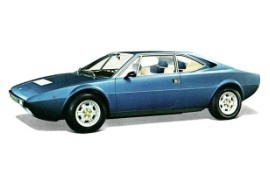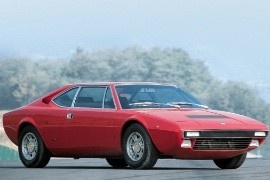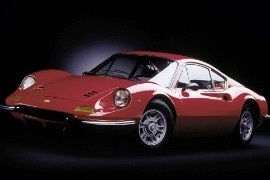
FERRARI Dino
Generations Timeline, Specs and Pictures

The second generation of Dino was introduced by Ferrari in 1973 but only with the three-liter engine, while the two-liter version appeared in 1975.
Ferrari still tried to make the Dino a sub-brand to compete against Porsche. The car didn’t even sport a Ferrari badge on it. Unlike its top brand, Enzo Ferrari built the Dino with classic steel bodies, while its V-12 vehicles already featured light-alloy materials.
Marcello Ghandini drew the wedged shapes of the second Dino generation, and Enzo Ferrari himself was involved in the process. Since he was a very tall person, that led to a higher greenhouse than Ghandini thought the car would be. The sporty coupe was made as a 2+2 vehicle with a decent interior room for rear passengers, leading to a longer cabin. At the front, the second Dino generation featured pop-up dual-headlights and a very small trunk, where the carmaker installed the spare wheel and a storage space good enough for a paper and a glossy magazine.
Inside, Ferrari installed two bucket seats at the front and a profiled for two bench in the rear. The dashboard was centered around the driver with a curved instrument panel and seven dials and gauges. The five-speed gear-stick popped through the center console between the front seats. Despite the fact that it wasn’t supposed to be an expensive vehicle, the Dino featured a leather-clad interior and carefully crafted fittings.
The 2.0-liter V-8 engine was placed transversely behind the rear seats and offered plenty of power for those times. The car was built to get a GT4 racing homologation and compete against the Porsche 912.

In 1973, at the Paris Motor Show, Ferrari unveiled the Dino GT4.
A shocking departure from the curvy Pininfarina design and an approach to the modernist, edgy style of the Bertone studios.
Enzo Ferrari tried to make the Dino a separate brand of the luxurious Ferrari. That is why the Dino didn’t feature any Ferrari badge on it. The car was easier to manufacture when compared to the V12 models from the Ferrari lineup. It was built as a 2+2 model to complement the 246 GT/GTS models in the Dino range.
It was the Fiat idea to assign the design task to the Bertone studios instead of the usual Pininfarina. For the U.S. market, the car featured a deep radiator grille. Since the Dino was the only Ferrari car that was sold on the North-American market, but it didn’t have a Ferrari badge, in mid-1975 Ferrari issued a directive to the Ferrari dealers to retrofit the existing stock with the prancing horse logo. This is why some Dinos in the U.S. will have one badge or another while some had both.
Inside, the car was made for a 2+2 seating configuration, with enough room in the back to accompany the front passengers. The luxurious seats featured leather upholstery and they were designed more for comfort than for hard-cornering. The dashboard was tilted toward the driver and in the middle of the steering wheel was a yellow button for the horn, with “Dino” word handwritten on it.
The dog-leg 5-speed gearbox already had the aluminum gate that made the Ferrari famous in the motoring history. The double-wishbone front suspension was complemented by a rear independent suspension. It is said that Niki Lauda, the former F1 champion, helped in developing the car to perform better on the road.

People wanted more power from the tiny Ferrari, so in 1969 the Dino 246 GT came out with a slightly bigger engine that cranked 195 HP.
The new 2.4-liter V6 still had a dual-overhead camshaft, but this time the block was made out of iron with alloy heads. Steel was also adopted for the bodywork to minimize cost and the wheelbase grew a bit. All these translate into a significant weight increase. Still, top speed and acceleration remained about the same.
There were 2,295 Dino 246 GT produced and 1,274 Spyder. Between 1969 and 1974 there were three Dino series, differentiated by wheels, windshield wiper coverage, and engine ventilation.

The Dino was the first mid-engine road car produced by Ferrari, but without wearing the prancing horse badge.
At the beginning of the ’60s, Enzo Ferrari considered that its company should build a more affordable sports car. The Italian carmaker needed to make 500 engines to qualify for Formula 2, and Fiat stepped in, producing and fitting them into an upmarket vehicle. The project started, and in 1968 he unveiled the car under the Dino brand. It costed half the price of a Ferrari Daytona introduced in the same year, but twice as much as a Jaguar E-Type V12. Nevertheless, the Italian carmaker managed to sell 246 vehicles, which was more than any other Ferrari built by that time.
With a bodywork designed by the Pininfarina Studios, the Dino sported a pair of round fixed headlights and a flat and low front area. The two-seat cabin featured a raked windshield and a vertical but very curved on the outer side, rear windscreen just in front of the engine compartment. Like any Ferrari from those days, the carmaker installed four round taillights.
The interior was elegant, with a pair of bolstered bucket seats. Its instrument cluster was behind the steering wheel and featured two large dials and no less than six additional gauges. It was a minimalist interior, which didn’t share the glamour or the luxury of a Daytona or any other Ferrari.
Since Ferrari built the bodywork from aluminum, it was light. Thus, the 180 hp engine didn’t have to work hard to push the 900 kg (1984 lbs) vehicle to high speeds. The carmaker paired the 2.0-liter V-6 engine to a five-speed manual gearbox.























































